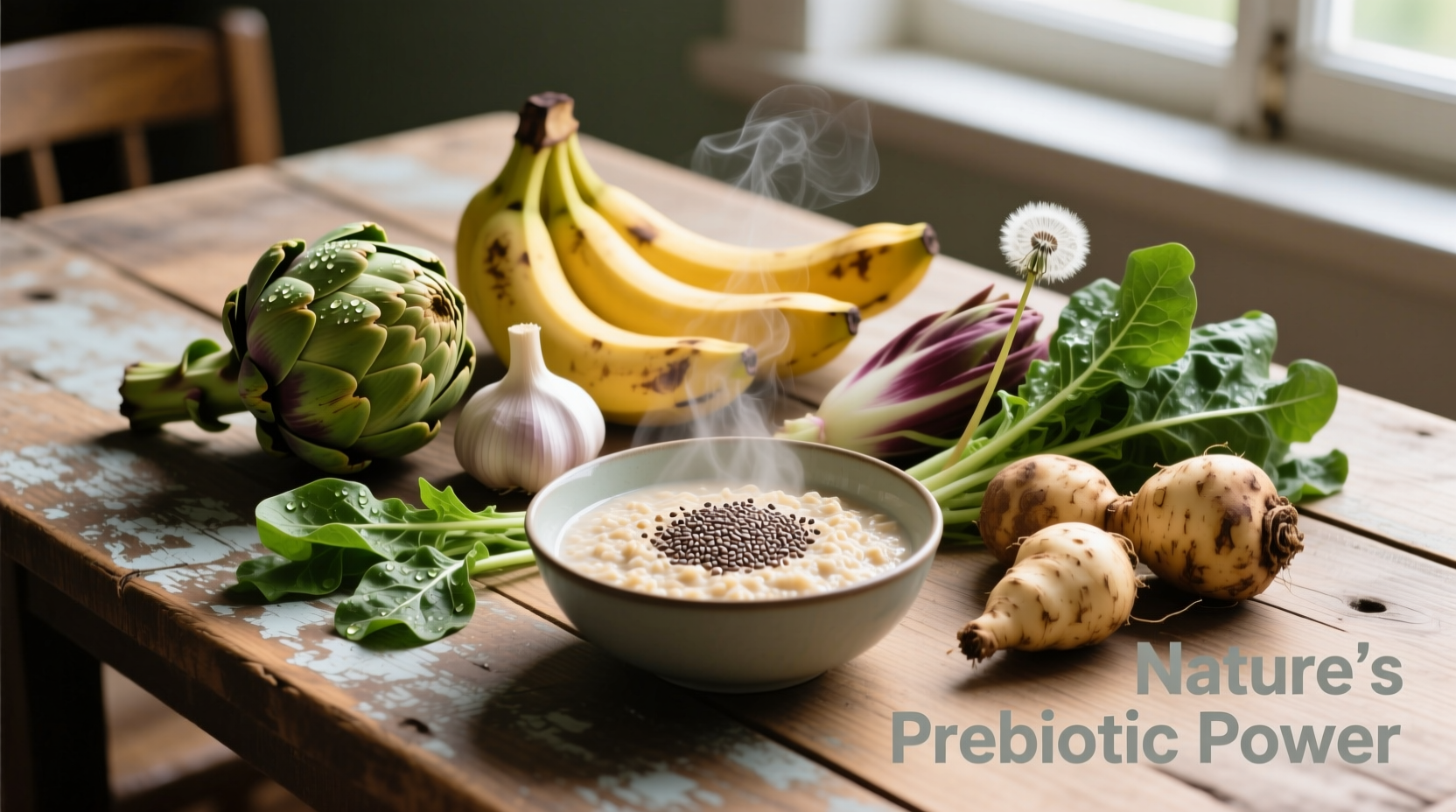Prebiotics are specific dietary fibers that feed beneficial gut bacteria. Top prebiotic foods include garlic, onions, leeks, asparagus, bananas, oats, and Jerusalem artichokes. Consuming 5-8 grams of prebiotics daily supports optimal gut health according to current research from the International Scientific Association for Probiotics and Prebiotics (ISAPP).
Understanding which foods contain prebiotics can transform your digestive health strategy. Unlike probiotics—which are the live bacteria themselves—prebiotics serve as the essential fuel that helps beneficial gut microbes thrive. This distinction matters because you could be eating probiotic-rich foods like yogurt without maximizing their benefits if you're not simultaneously consuming enough prebiotic fibers.
What Exactly Are Prebiotics and Why Your Gut Needs Them
Prebiotics are non-digestible food components that selectively stimulate the growth and activity of beneficial bacteria in your colon. The official scientific definition, established by the International Scientific Association for Probiotics and Prebiotics, specifies that true prebiotics must resist gastric acidity, remain undigested by human enzymes, and be fermented by intestinal microbiota.
The most common prebiotic compounds include inulin, fructooligosaccharides (FOS), and galactooligosaccharides (GOS). These specialized fibers pass through your upper digestive system unchanged, only becoming active when they reach your large intestine where they serve as nourishment for your gut microbiome.

Your Complete Guide to Prebiotic-Rich Foods
Not all high-fiber foods qualify as prebiotics. True prebiotic foods contain specific compounds that feed beneficial bacteria. Here's what you need to know about the most effective prebiotic food sources:
Vegetable Powerhouses
Garlic and onions lead the vegetable category with impressive prebiotic content. Just 100 grams of raw garlic contains approximately 16 grams of inulin. Leeks offer similar benefits with about 10 grams of inulin per 100 grams. Asparagus ranks among the top prebiotic vegetables, providing 2-3 grams of inulin per 100 grams.
Chicory root stands out as the most concentrated natural source of inulin, containing up to 68% inulin by weight. However, Jerusalem artichokes (also called sunchokes) provide a more accessible option with about 16-20% inulin content.
Fruit Sources
Under-ripe bananas contain resistant starch that functions as a prebiotic, offering about 1-2 grams per medium banana. As bananas ripen, this resistant starch converts to simple sugars. Apples contain pectin and small amounts of FOS, particularly in their skin.
| Prebiotic Food | Prebiotic Content per 100g | Key Prebiotic Compounds |
|---|---|---|
| Chicory root | 64-68g | Inulin |
| Jerusalem artichoke | 16-20g | Inulin |
| Garlic | 12-16g | Inulin, FOS |
| Leeks | 10-12g | Inulin |
| Asparagus | 2-3g | Inulin |
Prebiotics vs. Probiotics: Understanding the Critical Difference
Many people confuse prebiotics with probiotics, but they serve completely different functions in gut health. Probiotics are the live beneficial bacteria found in fermented foods like yogurt, kefir, and sauerkraut. Prebiotics are the specific fibers that feed those bacteria.
Think of it as a garden analogy: probiotics are the seeds (the beneficial bacteria you introduce), while prebiotics are the fertilizer (the nourishment that helps those bacteria grow and thrive). Research from the National Center for Biotechnology Information confirms that combining prebiotics with probiotics creates a synbiotic effect that significantly enhances gut microbiome diversity.
Practical Strategies for Incorporating Prebiotics Into Your Daily Diet
Reaching the recommended 5-8 grams of daily prebiotics doesn't require drastic dietary changes. Start your day with oatmeal topped with sliced bananas and a sprinkle of flaxseeds. For lunch, add raw onions and garlic to salads or sandwiches—these compounds remain most potent when consumed raw.
Cooking methods affect prebiotic content. Lightly steaming asparagus preserves more inulin than boiling, while roasting garlic reduces its prebiotic potency compared to using it raw. The Academy of Nutrition and Dietetics recommends gradually increasing prebiotic intake to avoid digestive discomfort, starting with 2-3 grams daily and building up over several weeks.
Scientific Evidence and Important Considerations
Multiple studies published in the journal Nutrients demonstrate that consistent prebiotic consumption increases beneficial bacteria like Bifidobacteria and Lactobacilli. However, individual responses vary significantly based on existing gut microbiome composition.
Context boundaries matter: individuals with irritable bowel syndrome (IBS) following a low-FODMAP diet may need to temporarily restrict certain prebiotic foods. The Monash University Low FODMAP Diet guidelines indicate that small portions of garlic (1 clove) and onions (10g) may be tolerable for some IBS patients, while larger amounts trigger symptoms.
Current research from the International Scientific Association for Probiotics and Prebiotics shows that prebiotic benefits typically become noticeable after 2-4 weeks of consistent consumption. Unlike probiotics, which require refrigeration and careful handling, prebiotic compounds remain stable during cooking and storage.
Frequently Asked Questions
How quickly do prebiotics work in the gut?
Most research indicates noticeable changes in gut microbiome composition within 2-4 weeks of consistent daily consumption. Individual responses vary based on existing gut health, with some people experiencing benefits within days while others may take several weeks.
Can you get too many prebiotics?
Yes, excessive prebiotic intake (typically over 15-20g daily) can cause bloating, gas, and abdominal discomfort, especially when introduced too quickly. The recommended daily intake is 5-8g. People with IBS or sensitive digestive systems should start with smaller amounts and increase gradually.
Do prebiotics help with weight management?
Emerging research suggests prebiotics may support weight management by promoting satiety hormones and improving metabolic health. A 2022 review in Nutrients journal found that daily prebiotic consumption was associated with modest reductions in body weight and improved insulin sensitivity in clinical trials.
Are prebiotic supplements as effective as food sources?
Whole food sources generally provide more comprehensive benefits than supplements due to additional nutrients and fiber diversity. However, supplements can be useful for targeted therapeutic doses. Research from the European Journal of Clinical Nutrition indicates that food-based prebiotics create more diverse microbiome changes compared to isolated supplement forms.











 浙公网安备
33010002000092号
浙公网安备
33010002000092号 浙B2-20120091-4
浙B2-20120091-4